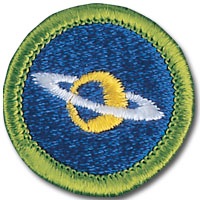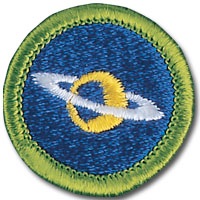Astronomy Merit Badge






Astronomy Merit Badge Supplementals
(updated Fri. Nov. 29, 2019)
The Astronomy merit badge requirements are listed at:
http://meritbadge.org/wiki/index.php/Astronomy,

which shares:
“In learning about astronomy, Scouts study how
activities in space affect our own planet and bear
witness to the wonders of the night sky: the nebulae, or giant clouds of gas and dust where new stars are born; old stars dying and exploding; meteor showers and shooting stars; the moon, plants and a dazzling array of stars.”

Astronomy, the two-part definition:
Astro
Definition of ASTR-
: star : heavens : outer space : astronomical <astrophysics>
source: http://www.merriam-webster.com/dictionary/astro
-nomy
Definition of -NOMY
: system of laws governing or sum of knowledge regarding a (specified) field <agronomy>
Origin of -NOMY
Greek -nomia, from nomos
source: http://www.merriam-webster.com/dictionary/-nomy

MeritBadge.org’s Astronomy page also contains an Astronomy Merit Badge worksheet to write your answers to the requirements.
Scouting.org’s Merit Badge page also includes digital copies of the requirements from the paper merit badge books.
The Astronomy requirements are available at: Astronomy [Merit Badge Book] - Current.

The purposes of this page are to
-
1)list the Astronomy merit badge requirements
and
-
2)provide information about the answers beyond those provided in the Merit Badge book; please know that only those answers in the book are required to complete the merit badge. The information on these pages should provide a deeper understanding of the points made in the Astronomy Merit Badge book.
Astronomy requirements are listed on these pages in bolded dark green text.

Merit Badge Requirement
-
1.Do the following:
-
(a)Explain to your counselor the most likely hazards you may encounter while participating in astronomy activities, and what you should do to anticipate, help prevent, mitigate, and respond to these hazards.
-
(b)Explain first aid for injuries or illnesses such as heat and cold reactions, dehydration, bites and stings, and damage to your eyes that could occur during observation.
-
(c)Describe the proper clothing and other precautions for safely making observations at night and in cold weather. Then explain how to safely observe the Sun, objects near the Sun, and the Moon.
Most of the information for this requirement can be found in the Merit Badge book, on pages 8-11.


Merit Badge Requirement
2. Explain what light pollution is and how it and air pollution affect astronomy.
Most of the information for this requirement can be found in the Merit Badge book, on pages 66-67.
This section provides some additional examples of light pollution.
As noted in the Astronomy Merit badge book, and also in Merriam Webster’s Dictionary, light pollution is:
Definition of light pollution
: artificial skylight (as from city lights) that interferes especially with astronomical observations
source: https://www.merriam-webster.com/dictionary/light%20pollution
Societies need to balance people being able to see when outside at night
and being able to see the nighttime sky.

Having dark skies can be an asset...
(found while still on-campus at 2014 STEM U)
One Texas town is encouraging astronomers to come and see the stars amid its truly dark skies:
http://cs.astronomy.com/asy/b/astronomy/archive/2014/12/19/more-dark-skies-texas-style.aspx

Not all light pollution comes from man-made lights...
...some natural sources, like Hawaii’s Kilauea Volcano can also provide light pollution
Astronomy Magazine also has some interesting photos and videos from both the 2018 Kilauea eruption and from the one in 2008.
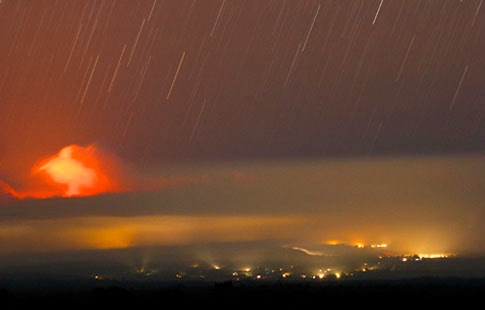
Earth and sky
Stephen James O'Meara
“On January 3, 2008, the ongoing eruption of Kilauea Volcano in the Big Island of Hawaii celebrated its 25th (silver) anniversary.“
http://astronomy.com/photos/picture-of-day/2008/01/earth-and-sky
More about the 2008 eruptions can be found at: https://volcanoes.usgs.gov/volcanoes/kilauea/geo_hist_2008.html.
In the September, 2018 issue, in their “Quantum Gravity - Everything You Need to Know About the Universe this Month...” section, in “Snapshot - Lava Lamp: Hawaiian Volcano shines at night,” Astronomy Magazine shows an image captured from atop Mauna Kea, looking back down at Hilo (just left of center, glowing in the clouds), and the 2018 Kilauea eruption, glowing brightly upward to the center-right of the image.
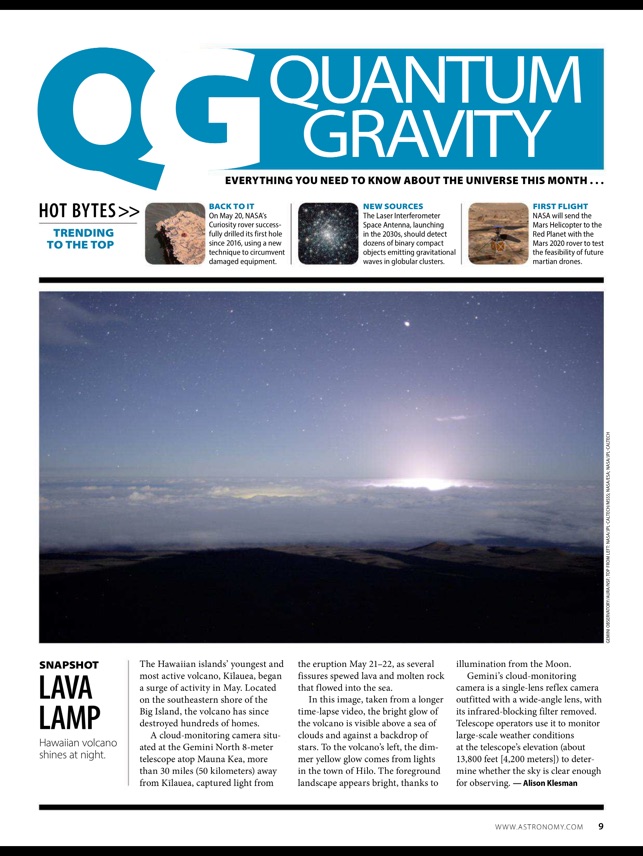
source: Astronomy Magazine
Kalmbach Publishing owns both Astronomy Magazine and Discover Magazine.
In May, Discover published a story about the 2018 Kilauea eruption, and also shared a video, looking to also be from atop Mauna Kea (near where they captured the photo above?), looking back down toward Kilauea that shows the large ash plume that apparently rose 30,000 feet into the sky.
Discover Magazine link: http://blogs.discovermagazine.com/imageo/2018/05/17/video-captures-ash-plume-from-hawaii-volcano-exploding-higher-than-everest/#.W3mxci3MyOE
YouTube link of the video: https://youtu.be/ldlr0BWWmQ4


Merit Badge Requirement
-
3.With the aid of diagrams (or real telescopes if available), do each of the following:
(a) Explain why binoculars and telescopes are important astronomical tools. Demonstrate or explain how these tools are used.
(b) Describe the similarities and differences of several types of astronomical telescopes, including at least one that observes light beyond the visible part of the spectrum (i.e., radio, X-ray, ultraviolet, or infrared).
(c) Explain the purposes of at least three instruments used with astronomical telescopes.
(d) Describe the proper care and storage of telescopes and binoculars both at home and in the field.
Most of the information for this requirement can be found in the Merit Badge book, on pages 54-65.
This section provides some additional information about telescopes and binoculars.

-
3.With the aid of diagrams (or real telescopes if available), do each of the following:
(a) Explain why binoculars and telescopes are important astronomical tools. Demonstrate or explain how these tools are used.
The short answer is that binoculars and telescopes let us see things that we cannot see with just our own eyes; they let us see things that are far away.

-
3.With the aid of diagrams (or real telescopes if available), do each of the following:
(b) Describe the similarities and differences of several types of astronomical telescopes, including at least one that observes light beyond the visible part of the spectrum (i.e., radio, X-ray, ultraviolet, or infrared).
This section provides some additional information about the different kinds of telescopes.
To understand why there is a need for different kinds of telescopes, we need to understand the different kinds of energy that are found in the electromagnetic spectrum.
The visible light we see with our eyes is only one type of energy.
Different kinds of telescopes help us detect the different types of electromagnetic energy that are observable.
Encyclopedia Britannica shares:
“The entire electromagnetic spectrum, from the lowest to the highest frequency (longest to shortest wavelength), includes all radio waves (e.g., commercial radio and television, microwaves, radar), infrared radiation, visible light, ultraviolet radiation, X-rays, and gamma rays.”
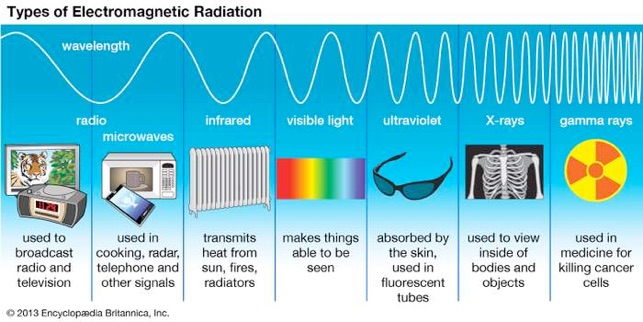
image source:
https://www.britannica.com/science/electromagnetic-spectrum
This 2-minute video provides some good information:
“What is the Electromagnetic Spectrum?”
https://www.youtube.com/watch?v=m4t7gTmBK3g
Observing Energy as Visible Light
There are different kinds of telescopes for visible light, and they are categorized as
-
-Refractor telescopes - light is focused through a series of lenses, and not through any mirrors
-
-Reflector telescopes - light is focused through a series of curved mirrors, and some also use lenses and some do not use lenses
Refractor telescopes tend to be longer and more narrow in shape, and because the mirrors in reflector telescopes redirect the light inside the tube to move another direction, reflector telescopes tends to have shorter tubes.
Dr. Wilking at UMSL shares this document, which provides a good diagram on p. 2 that shows various how different refracting and reflecting telescopes, and how binoculars, gather visible light.
There is a good diagram on p. 2 of this document, which is shared with us that shows various types of reflecting telescopes:
http://www.danlessmann.com/articles/telescope%20optics%20101-part1.pdf

This section shares real life examples of refractor and reflector telescopes.
Refractor Telescopes
Yerkes Observatory
The largest refractor telescope in the world is at the Yerkes Observatory in Wisconsin.
The primary lens is 40-inches, and the tube is 63-feet long, which is much longer than the trailer on an 18-wheeler truck.
Size puts limits on refractor telescopes, which is why Yerkes became the largest in the world, and why larger telescopes are all reflector telescopes.
Astronomy magazine provides good background:
“The impressive lens size, which is the glory of the telescope, is also why Yerkes is a sort of scientific dead end. Simply put, there’s a practical limit to how large you can make a lens, and Yerkes’ 40-inch telescope butts against that limit. Lenses are made from a single piece of material, which must be free of defects. (Mirrors only have to be defect-free on the surface, so they can be made much bigger, or even built up out of multiple segments.) Even if it’s perfect after manufacture, changing gravitational stresses as the telescope moves can alter the shape of the lens subtly, leading to distorted images. In addition, the edges of lenses are tapered, which makes them act like prisms, splitting the colors of light from whatever object is being observed.
Finally, the larger the lens, the longer the telescope tube must be to focus the resulting image.”
This is a picture of the Yerkes refractor telescope:
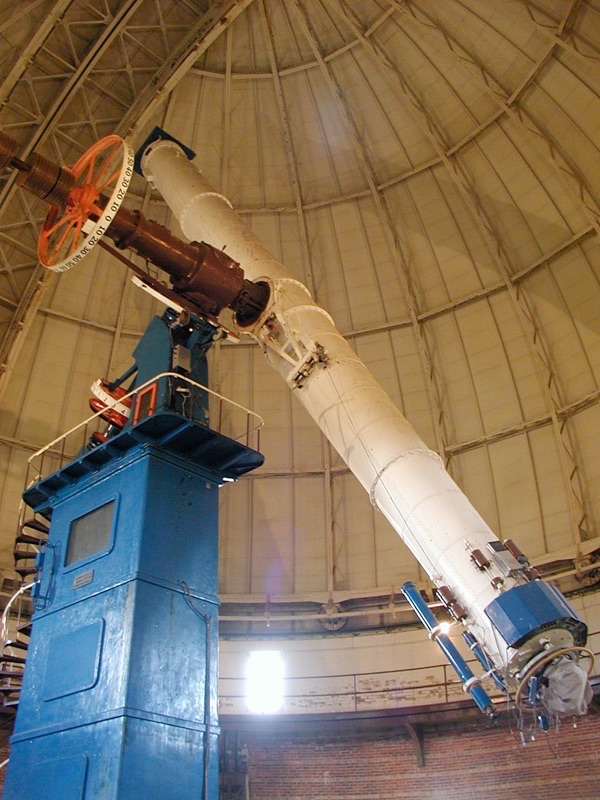
image source: http://astronomy.com/news/2018/03/yerkes-observatory-is-closing-its-doors
Reflector Telescopes
Mt. Wilson Observatory
After it was recognized that the Yerkes telescope reaches a practical limit for largest size for a refractor telescope, efforts moved to building larger and larger reflecting telescopes...
... and the then-largest telescope was built atop Mt. Wilson, outside Los Angeles. The 100-inch Hooker telescope is where Sir Edwin Hubble, from Marshfield, MO, determined the rate at which the universe is expanding (which is called the Hubble constant), discovered that the Andromeda and other galaxies are outside our Milky Way, and more, and his efforts are what led NASA to name the Hubble Space Telescope after him.

image source: https://www.mtwilson.edu; note: this is the 60-inch telescope
This is an image of the 100-inch reflector telescope at Mt. Wilson:

image source: https://www.mtwilson.edu
Palomar Observatory
Success at Mt. Wilson fueled the desire to explore further, which required a larger telescope. Started in the 1920s, slowed by the Great Depression and WWII, the 200-inch telescope at Palomar Observatory observed first light in 1949.
The Mt. Palomar telescope was the largest built using a single pane of glass. There are larger and larger reflector telescopes being built, and they use many different smaller mirrors working together. While the USSR did build a larger, 238-inch telescope, called BTA-6, but “BTA-6 has never been able to operate near its theoretical limits.”
source: https://en.wikipedia.org/wiki/BTA-6
The Mt. Palomar telescope remains the largest built using a single pane of glass.
The light gathering capabilities of Mt. Palomar helped determine the size of the universe more precisely, discovered quasars, discovered the first brown dwarf, and discovered the first TNO / Trans-Neptunian Objects, now called dwarf planets - Quaoar Sedna, and Eris.
source: https://www.space.com/26310-palomar-observatory.html
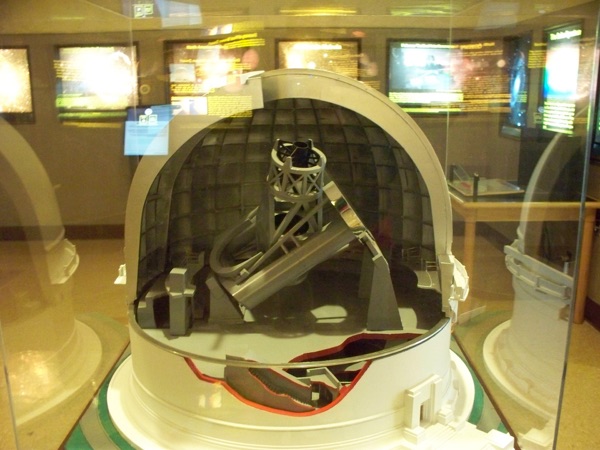
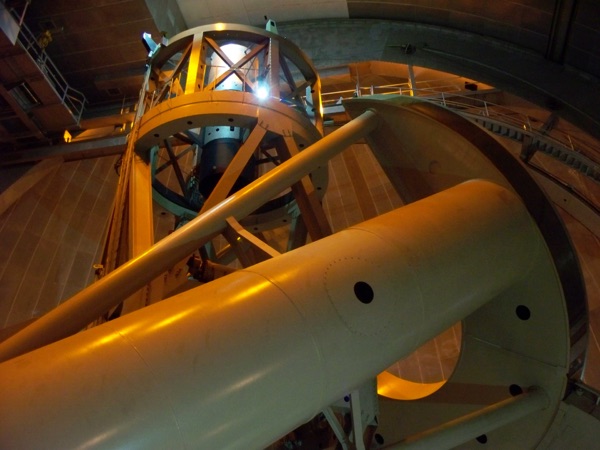
image source, these two photos: VanVooren personal collection, captured in person at Mt. Palomar; see also http://vanvooren.us/VV/Astronomy.html
You can learn more about Mr. Palomar history at:
http://www.astro.caltech.edu/palomar/about/history.html
W. M. Keck Observatory
The W. M. Keck Observatory is located atop Mauna Kea on the Big Island of Hawaii. The Keck Observatory houses two matching reflecting telescopes that are comprised of 36 smaller mirrors working together to focus light, all acting as one larger 10 meter / 33 foot telescope.
Since the Keck telescopes were completed in 1993, larger telescopes have been built, and even larger telescopes are planned... all with the same approach of using many smaller mirrors reflecting light and working together as a single mirror.
Tis wikipedia page contains more information about these large telescopes: https://en.wikipedia.org/wiki/List_of_largest_optical_reflecting_telescopes
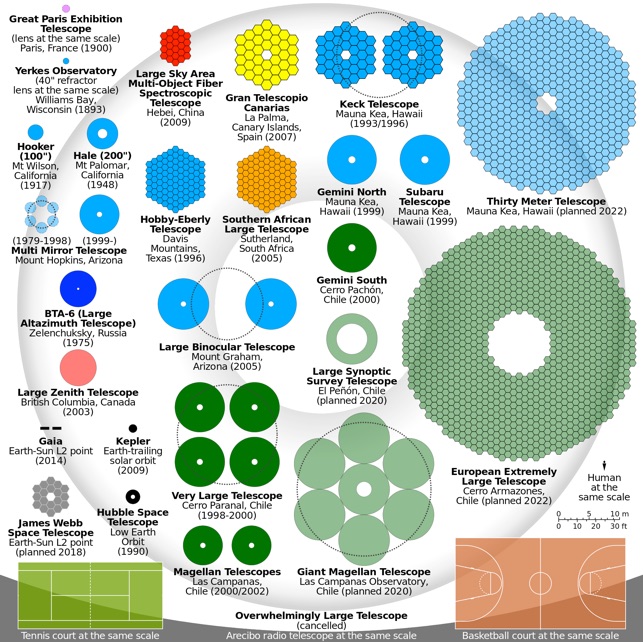
image source: https://en.wikipedia.org/wiki/W._M._Keck_Observatory#/media/File:Comparison_optical_telescope_primary_mirrors.svg
Observing Energy as that is not Visible Light
Since visible light is only one kind of electromagnetic energy that can be detected, NASA and other space agencies, and other groups, have made telescopes to detect these other types of energy.
When scientists study astronomical objects - galaxies, nebulas, stars, etc - in different types of energy, they can better understand these objects.
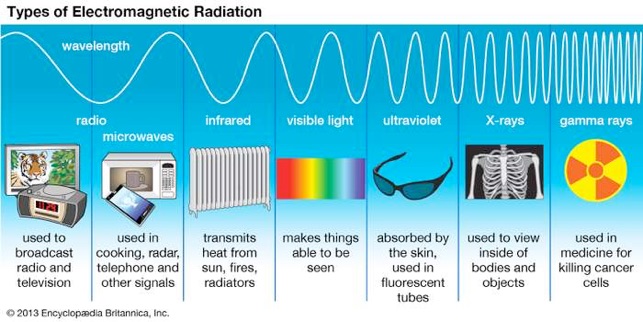
image source:
https://www.britannica.com/science/electromagnetic-spectrum
Since telescopes in space are able to observe without any effects from earth’s atmosphere, there are many different space telescopes, detecting the different types of electromagnetic energy.
NASA and other space agencies have various space telescopes in orbit around earth:
https://en.wikipedia.org/wiki/List_of_space_telescopes
This InfoGraphic in the February 2015 issue of Astronomy magazine shows the relative sizes of, and the different designs of, NASA’s space telescopes.

This infographic shows the relative differences in the wavelengths of electromagnetic radiation, and also shares the numbers of space telescopes observing the different wavelengths. Astronomy Magazine provided this graphic in their October, 2014 issue:
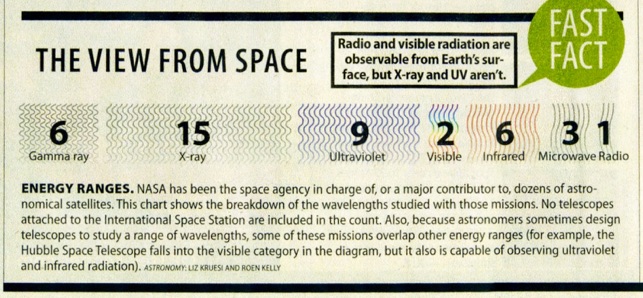

-
3.With the aid of diagrams (or real telescopes if available), do each of the following:
(c) Explain the purposes of at least three instruments used with astronomical telescopes.
Most of the information for this requirement can be found in the Merit Badge book, on pages 62-65.
This section provides some additional examples of light pollution.
-
1)Cameras can be attached to telescopes, to capture photos of the sky. Cameras could be film, digital, smartphone and/or CCD / Charged Coupled Devices.
-
2)Spectrographs can be attached to telescopes, to separate the light being captured into its individual colors, and by observing the absorption lines, you can determine the elements that the stars are composed of.
-
3)Lasers are used to improve image quality. The observatories shine a laser into the sky, and the computers determine how the atmosphere changes the laster’s light, making it more fuzzy. The computers determine how to make the laser image clear again; they then know how the atmosphere is making images in the telescope more fuzzy, and by applying the same image corrections to the images in he telescope, those images in the telescope can be more clear and well defined than if the laser had not been used. This presentation, starting on p. 6, shows some examples of how adaptive optics works - https://www.noao.edu/meetings/ao-aas/talks/MAX_Review_203.01Mac.pdf.

With the aid of diagrams (or real telescopes if available), do each of the following:
(d) Describe the proper care and storage of telescopes and binoculars both at home and in the field.
Most of the information for this requirement can be found in the Merit Badge book, on pages 60-61.



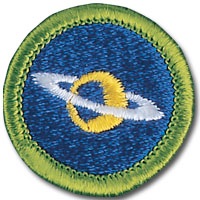
These are all of the links to the Astronomy Merit Badge pages:
Astronomy Merit Badge - Extra “Fun Facts”
Astronomy - Great American Eclipse
Astronomy - Great American Eclipse 2017

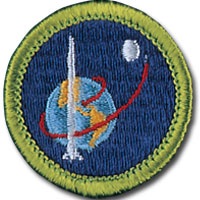
These are all of the links to the Space Exploration Merit Badge pages:
New Horizons - Mission Overview
New Horizons - Pluto Resources


The images from Mr. Berman’s “Secrets of the Night Sky...” and Outdoor Photographer were scanned directly from the book using the Halo Scanner Mouse - http://shop.halo2cloud.com/collections/computer-and-backup/products/scanner-mouse, which I received as a Christmas present from my mother in 2013.



Regardless your desire to pursue an astronomical career, it is hoped that you learned enough about astronomy through this merit badge to at least be interested to continuously look up at the sky in awe and wonder. If you pursue with enthusiastic interest, that’s great. If you do make a career in the field, GREAT.
May you be better off having completed your Astronomy Merit Badge than you were before you started.
